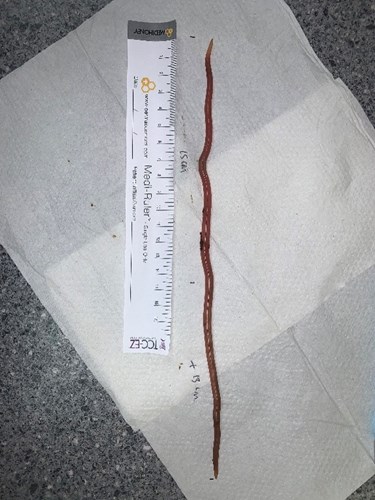Pavilion Publishing and Media Ltd
Blue Sky Offices Shoreham, 25 Cecil Pashley Way, Shoreham-by-Sea, West Sussex, BN43 5FF, UNITED KINGDOM
The medical team at a district general hospital were asked to assess a 75-year-old Caucasian woman who presented with the following.
After opening her bowels that morning she felt there was still more to come. To her surprise she pulled out a thread-like object. She instantly recognised it was a worm so placed it in a jar and took it initially to a pharmacist for advice, only to be directed to A&E.
Although she was calm there was much excitement amongst the health professionals as they observed the eight-inch long round worm known formally as Ascaris lumbricoides.
The patient gave no other history other than noticing she had lost four pounds in weight over the past few weeks.
Despite her age, she worked regularly at a garden centre. She had not been abroad for the past two years and informed us that she has never visited Asia or Africa. The patient owned a cat and stated she cleared the litter tray using gloves.
Physical examination proved to be unremarkable, including a normal respiratory and gastrointestinal systems. Rectal examination was not performed.

Laboratory investigations included normal hemoglobin, CRP, white cell and eosinophil counts. Lymphopenia was present (lymphocyte count was 0.95 x 109/L – physiological range is 1.5- 4.0×109/L). Chest x-ray showed normal lung fields.
The on call microbiologist advised for stools to be collected before starting any treatment. The stools showed scanty presence of fertile Ascaris lumbricoides ova.
The patient was treated with mebendazole 500mg as a single dose from the hospital.
What is Ascaris lumbricoides?
Ascaris lumbricoides is a type of parasitic nematode (round worm). It’s major hosts are humans and pigs. Ascariasis are rare in the UK and most infections that occur are usually acquired abroad.1
Life cycle of Ascaris lumbricoides
The parasite is transmitted to humans via the fecal-oral route when uncooked contaminated food is ingested allowing the the parasite’s eggs to enter the gut.
The eggs reach the small intestines of the host. Larvae then emerge and penetrate the mucosa of the small intestine and travel via the portal circulation onwards to the lungs. The larvae enter the alveolar spaces and migrate up the major airways. They are coughed up out of the trachea and unknowingly swallowed by the patient, thereby re-entering the gastrointestinal system. Reaching the small intestine for a second time they now develop into both male and female adult forms; the latter produces eggs that are passed through the faeces into the external environment.2,3
Symptoms and complications
Most patients sufferings from ascariasis are often completely asymptomatic.
Intestinal infections can cause the patient to experience non-specific symptoms such as abdominal discomfort or pain. It can lead to vitamin A or protein deficiency. In more severe cases masses of worms may lead to patients’ experiencing bowel obstruction.
If the infection spreads to the lungs, the patient may experience persistent cough, breathlessness and wheezing.
Sometimes the worms can cause hypersenstivity reactions which may manifest as fever, urticaria and angioneurotic oedema.4
Investigations (= diagnosis)
Microscopic examination of the patient’s stool sample can detect the parasitic eggs, but there may be a 40 day lag period after the initial exposure.
Blood sampling may show eosinophilia. Radiology imaging can be used to show the presence of worms, for example x-rays or ultrasound.4
Treatment and prevention of Ascaris lumbricoides
Mebendazole is the first-line of treatment of choice as it disrupts the carbohydrate metabolism and inhibits microtubule polymerisation in the intestinal cells of the parasite. An alternative drug that could be used is levamisole.5
To resolve cases of heavy infection, surgery may be required either to remove the worms or repair the damage caused (for example in the form of intestinal blockages or holes).
To prevent ascariasis infection patients should:
- Avoid touching soil that might be contaminated with human or animal faeces.6
- Thoroughly wash hands with warm water and soap before preparing food. Fresh produce should be preferably cooked in hot water and uncooked food should be washed before consumption.
- Transmission of the infection can be reduced through communities by having an effective sewage system to ensure there is appropriate disposal of faeces.
Helminths
Ascaris lumbricoides are characterised by predominantly being unsegmented worms, with separate sexes differing morphologically. They are one type of nematode that can cause infections in humans and are often classified by the main site of infection of the adult parasite within the body.7
|
Habitat of adult nematode |
Nematode |
|
Small intestine |
Ascaris lumbricoides (Ascariasis) Strongyloides stercoralis (strongyloidiasis) Hook worm |
|
Large intestine |
Trichuris trichiura Enterobius vermicularis |
|
Lymphatic |
Wuchereria bancrofti Brugia Malayi Both of these parasites are capable of causing lymphatic filariasis (elephantiasis) |
|
Subcutaneous |
Loa loa Onchocerca |
Nematodes are one type of helminth, the other two medically important classes are:
- Trematodes – e.g. liver flukes (fasciola hepatica), Schistosomiasis
- Cestodes – e.g. pork tapeworm (taenia solium).
Batool Yousouf Adenwala is a 5th year UK medical student studying in the Czech Republic at Palacky University
Dr Amir Hussain Baluwala, Respiratory Medicine, Warrington Hospital
References
- CDC. Available from: https://www.cdc.gov/parasites/ascariasis/gen_info/faqs.html
- CDC – Ascariasis [Internet]. Cdc.gov. 2020 [cited 19 August 2021]. Available from: https://www.cdc.gov/parasites/ascariasis/index.html
- Centers for Disease Control and Prevention [Internet]. CDC – Ascariasis – Biology; 2019 [cited 2021 Aug 19]. Available from: https://www.cdc.gov/parasites/ascariasis/biology.html
- Ascariasis – Diagnosis and treatment – Mayo Clinic [Internet]. Mayoclinic.org. 2020 [cited 19 August 2021]. Available from: https://www.mayoclinic.org/diseases-conditions/ascariasis/diagnosis-treatment/drc-20369597
- Mebendazole: Uses, Interactions, Mechanism of Action | DrugBank Online. (2005, June 13). DrugBank Online | Database for Drug and Drug Target Info. https://go.drugbank.com/drugs/DB00643
- NICE [Internet]. 2021 [cited 2021 Aug 19]. Available from: https://bnf.nice.org.uk/treatment-summary/helminth-infections.html
- Mahmud R, Ai Lian Lim Y, Amir A. Medical Parasitology. Springer International Publishing AG 2017; 2018.


